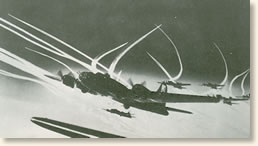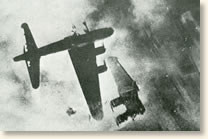|
Life and Death Aboard a B-17, 1944
America joined Britain's strategic air campaign designed to destroy Nazi Germany's industrial capacity soon after her entrance into World War Two. Launching Boeing B-17 "Flying Fortresses" and Consolidated B-24 "Liberators" from bases in England's eastern countryside, the Americans bombed their targets during the day while the British attacked at night.
Up to 1,000 of these heavy bombers would take part in a raid - the planes flying
in a three dimensional formation in which boxes of aircraft were stacked one
above the other to take full advantage of their combined defensive firepower.
The early confidence that the bombers' defenses alone could repel enemy fighter
attacks was quickly shattered. Losses were high. It was not until long-range
fighter aircraft capable of escorting the bombers to and from their targets
were made available that losses dropped to an acceptable level.
Manned by a crew of 10, the many heavy machine guns that bristled from the front, back, top, bottom and sides of the four-engine

B-17s fly in formation. Overhead, vapor trails
trace the weaving path of their fighter escort.
|
B-17 prompted its nickname, the "Flying Fortress." On days that a mission was planned, the airmen would be awakened in the early morning hours and fed a hearty breakfast followed by a briefing describing the mission. They would then be taken to their planes and await the signal to take off. Once aloft, brightly colored "lead-ships" would direct the bombers to pre-determined points where they would organize themselves into their attack formations.
Missions that penetrated deep into enemy territory could last up to eight hours and be filled with anxious anticipation as all eyes searched the skies for enemy defenders. They could expect attacks by fighters armed with machineguns, canon and rockets as well as heavy antiaircraft fire from the ground and even bombs dropped from above. The bombers were expected to maintain their positions at all costs - in order to provide the most effective defensive fire and to assure the most devastating results once their bombs were dropped.
The planes were unheated and open to the outside air. The crew wore electrically heated suits and heavy gloves that provided some protection against temperatures that could dip to 60 degrees below zero. Once above 10,000 feet they donned oxygen masks as the planes continued to climb to their operational level that could be as high as 29,000 feet. Nearing the target, each crew member would don a 30-pound flak suit and a steel helmet designed to protect against antiaircraft fire. Parachutes were too bulky to be worn all the time, but crewmen did wear a harness that allowed them to quickly clip on their parachute when needed.
Prior to 1944, a crewman's tour of duty was set at 25 missions. As a measure
of the hazards they would encounter, it is estimated that the average crewman
had only a one in four chance of actually completing his tour of duty.
Joseph Hallock was a twenty-two-year-old first lieutenant serving as the bombardier aboard "Ginger" a B-17 flying out of its base north of London. Hallock dropped out of college to enlist in the Army Air Force in June 1942. After training as a bombardier, he arrived in England in November 1943 and began his combat career on the last day of the year:
"My first raid was on December thirty-first, over Ludwigshaven. Naturally, not knowing what it was going to be like, I didn't feel scared. A little sick, maybe, but not scared. That comes later, when you begin to understand what your chances of survival are. Once we'd crossed into Germany, we spotted some flak, but it was a good long distance below us and looked pretty and not dangerous: different-colored puffs making a soft, cushiony-looking pattern under our plane. A bombardier sits right in the plexiglas nose of a Fort, so he sees everything neatly laid out in front of him, like a living-room rug. It seemed to me at first that I'd simply moved in on a wonderful show.' I got over feeling sick, there was so much to watch.
We made our run over the target, got our bombs away, and apparently did a good job. Maybe it was the auto-pilot and bomb sight that saw to that, but I'm sure I was cool enough on that first raid to do my job without thinking too much about it. Then, on the

The B-17G
|
way home, some Focke-Wulfs showed up, armed with rockets, and I saw three B-I7s in the different groups around us suddenly blow up and drop through the sky. Just simply blow up and drop through the sky. Nowadays, if you come across something awful happening, you always think, 'My God, it's just like a movie,' and that's what I thought. I had a feeling that the planes weren't really falling and burning, the men inside them weren't really dying, and everything would turn out happily in the end. Then, very quietly through the interphone, our tail gunner said, 'I'm sorry, sir, I've been hit.'
I crawled back to him and found that he'd been wounded in the side of the head - not deeply but enough so he was bleeding pretty bad. Also, he'd got a lot of the plexiglas dust from his shattered turret in his eyes, so he was, at least for the time being, blind.Though he was blind, he was still able to use his hands, and I ordered him to fire his guns whenever he heard from me. I figured that a few bursts every so often from his fifties would keep the Germans off our tail, and I also figured that it would give the kid something to think about besides the fact that he'd been hit. When I got back to the nose, the pilot told me that our No. 4 engine had been shot out. Gradually we lost our place in the formation and flew nearly alone over France. That's about the most dangerous thing that can happen to a lame Fort, but the German fighters had luckily given up and we skimmed over the top of the flak all the way to the Channel."
In early 1944 the number of missions required to complete
his tour of duty was extended from 25 to 30. This meant that Lt. Hallock and
his buddies, each of whom had been counting down each mission, now had
five additional to fly. We pick up his story as he begins his 27th (and worst)
mission:
"We had a feeling, though, that this Augsburg show was bound to be tough, and it was. We made our runs and got off our bombs in the midst of one hell of a dogfight. Our group leader was shot down and about a hundred and fifty or two hundred German fighters swarmed over us as we headed for home. Then, screaming in from someplace, a twenty millimeter cannon shell exploded in the nose of our Fort. It shattered the plexiglas, broke my interphone and oxygen connections, and a fragment of it cut through my heated suit and flak suit. I could feel it burning into my right shoulder and arm. My first reaction was to disconnect my heated suit. I had some idea that I might get electrocuted if I didn't.
I crawled back in the plane, wondering if anyone else needed first aid. I couldn't communicate with them, you see, with my phone

A B-17 succumbs to an attack.
|
dead. I found that two shells had hit in the waist of the plane, exploding the cartridge belts stored there, and that one waist gunner had been hit in the forehead and the other in the jugular vein. I thought, 'I'm wounded, but I'm the only man on the ship who can do this job right.' I placed my finger against the gunner's jugular vein, applied pressure bandages, and injected morphine into him. Then I sprinkled the other man's wound with sulfa powder. We had no plasma aboard, so there wasn't much of anything else I could do. When I told the pilot that my head set had been blown off, the tail gunner thought he'd heard someone say that my head had been blown off, and he yelled that he wanted to jump. The pilot assured him that I was only wounded. Then I crawled back to the nose of the ship to handle my gun, fussing with my wounds when I could and making use of an emergency bottle of oxygen.
The German fighters chased us for about forty-five minutes. They came so close that I could see the pilots' faces, and I fired so fast that my gun jammed. I went back to the left nose gun and fired that gun till it jammed. By that time we'd fallen behind the rest of the group, but the Germans were beginning to slack off. It was turning into a question of whether we could sneak home without having to bailout. The plane was pretty well shot up and the whole oxygen system had been cut to pieces. The pilot told us we had the choice of trying to get back to England, which would be next to impossible, or of flying to Switzerland and being interned, which would be fairly easy. He asked us what we wanted to do. I would have voted for Switzerland, but I was so busy handing out bottles of oxygen that before I had a chance to say anything the other men said, 'What the hell, let's try for England.' After a while, with the emergency oxygen running out, we had to come down to ten thousand feet, which is dangerously low. We saw four fighters dead ahead of us, somewhere over France, and we thought we were licked. After a minute or two we discovered that they were P-47s, more beautiful than any woman who ever lived. I said, 'I think now's the time for a short prayer, men. Thanks, God, for what you've done for us.'"
The twenty-eighth [mission]was on Berlin, and
I was scared damn near to death. It was getting close to the end and my luck
was bound to be running out faster and faster. The raid wasn't too bad, though,
and we got back safe. The twenty-ninth mission was to Thionville, in France,
and all I thought about on that mission was 'One more, one more, one more.' My
last mission was to Saarbriicken. One of the waist gunners was new, a young kid
like the kid I'd been six months before. He wasn't a bit scared - just cocky
and excited. Over Saarbriicken he was wounded in the foot by a shell, and I had
to give him first aid. He acted more surprised than hurt. He had a look on his
face like a child who's been cheated by grownups.
That was only the beginning for him, but it was the end for me."
References:
The interview with Josepgh Hallock was originally published
in the New Yorker Magazine on August 12, 1944, republished in The New
Yorker Book of War Pieces (1947);Pitt, Barrie (ed.), The Military History of
World War II (1986); Stokesbury, James L., A Short History of World War II (1980).
How To Cite This Article:
"Life and Death Aboard a B-17, 1944," EyeWitness to History, www.eyewitnesstohistory.com (2005).
|






